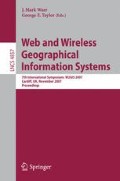Abstract
One of the challenges raised by the construction of the semantic Web lies in the analysis and management of complex relationships (thematic, spatial and temporal) connecting several resources. The automatic discovery of such relations will improve the current capabilities of existing search engines. Spatial information plays an important role in the resources available on the Web, thus, integrating spatial criteria into queries addressed to search engines would increase the power of expression of the formulation and will improve the search result. However, ontology languages of the semantic Web, OWL in particular, still do not have the expected specific characteristics for a well adapted representation and exploitation of spatial data. We present here ONTOAST, a spatial ontology modeling and reasoning system. ONTOAST manages qualitative spatial relations which can be used to express spatial queries. It also handles the inference of new qualitative relations, thus increasing the spatial-based search capabilities.
Access this chapter
Tax calculation will be finalised at checkout
Purchases are for personal use only
Preview
Unable to display preview. Download preview PDF.
References
Berners-Lee, T., Hendler, J.A., Lassila, O.: The Semantic Web. Scientific American 284(5)002E, 34–43 (2001)
Gruber, T.R.: Towards Principles for the Design of Ontologies Used for Knowledge Sharing. In: Formal Ontology in Conceptual Analysis and Knowledge Representation, Kluwer Academic Publishers, Dordrecht (1993)
McGuinness, D., van Harmelen, F.: OWL Web Ontology Language -Overview (2005), http://www.w3.org/TR/2004/REC-owl-features-20040210/
Page, M., Gensel, J., Capponi, C., Bruley, C., Genoud, P., Ziébelin, D., Bardou, D., Dupierris, V.: A New Approach in Object-Based Knowledge Representation: the AROM System. In: Monostori, L., Váncza, J., Ali, M. (eds.) IEA/AIE 2001. LNCS (LNAI), vol. 2070, pp. 113–118. Springer, Heidelberg (2001)
Moisuc, B., Davoine, P.-A., Gensel, J., Martin, H.: Design of Spatio-Temporal Information Systems for Natural Risk Management with an Object-Based Knowledge Representation Approach. Geomatica 59(4) (2005)
Miron, A., Capponi, C., Gensel, J., Villanova-Oliver, M., Ziébelin, D., Genoud, P.: Rapprocher AROM de OWL... Langages et Modéles á Objets. Toulouse, France (in French) (2007)
Cohn, A., Hazarika, S.M.: Qualitative Spatial Representation and Reasoning: An Overview. In: Fundamenta Informaticae, vol. 46, pp. 1–29. IOS Press, Amsterdam (2001)
Katz, Y., Grau, B.C.: Representing Qualitative Spatial Information in OWL-DL. In: Proceedings of OWL: Experiences and Directions (2006)
Dolbear, C., Hart, G.: So what’s so special about spatial? Ordnance Survey of Great Britain (2006)
Capponi, C.: Type extensibility of a knowledge representation system with powersets. In: Raś, Z.W., Skowron, A. (eds.) ISMIS 1997. LNCS, vol. 1325, pp. 338–347. Springer, Heidelberg (1997)
OpenGIS home page: OpenGIS Consortium, OpenGIS Reference Model (2004), http://www.opengis.org/
Protégé: La Création d’Ontologies Web Sémantique avec Protégé-2000 (2000), http://www.emse.fr/~beaune/websem/WS_Protege-2000.pdf
iAnnotate Tab documentation page: http://www.dbmi.columbia.edu/~cop7001/iAnnotateTab/iannotate_doc.htm
Cohn, A.: Qualitative Spatial Representations. In: IJCAI-99 Workshop Adaptive Spatial Representations of Dynamic Environments (1999)
Randell, D.A., Cui, Z., Cohn, A.G.: A spatial logic based on regions and connection. In: Proc. 3rd Int. Conf. on Knowledge Representation and Reasoning, pp. 165–176. Morgan Kaufmann, San Mateo (1992)
Randell, M., Cohn, A.G.: Modeling topological and metrical properties of physical processes. In: Proceeding 1st International Conference on the Principles of Knowledge Representation and Reasoning, Los Altos, pp. 55–66 (1989)
Egenhofer, M.: Point-set Topological Spatial Relations. International Journal of Geographical Information Systems, 161–174 (1991)
Egenhofer, M., Rodriguez, M.A., Blaser, A.: Query Pre-processing of Topological Constraints: Comparing a Composition-Based with Neighborhood-Based Approach. In: Hadzilacos, T., Manolopoulos, Y., Roddick, J.F., Theodoridis, Y. (eds.) SSTD 2003. LNCS, vol. 2750, pp. 362–379. Springer, Heidelberg (2003)
Dutta, S.: Qualitative Spatial Reasoning: A Semi-Quantitative Approach Using Fuzzy Logic. In: Buchmann, A.P., Smith, T.R., Wang, Y.-F., Günther, O. (eds.) SSD 1989. LNCS, vol. 409, pp. 345–364. Springer, Heidelberg (1990)
Hong, J.: Qualitative Distance and Direction Reasoning in Geographic Space. PhD.Thesis, University of Main (1994)
Renz, J.: Qualitative Spatial Reasoning with Topological Information. LNCS (LNAI), vol. 2293, pp. 31–40. Springer, Heidelberg (2002)
Frank, A.U.: Qualitative Spatial Reasoning: Cardinal Directions as an Example. International Journal of Geographical Information Science 10(3), 269–290 (1996)
Goyal, R.K., Egenhofer, M.: Cardinal Directions between Extended Spatial Objects. IEEE Transactions on Knowledge and Data Engineering (2001)
Sheth, A., Arpinar, I.B., Kashyap, V.: Relationships at the Heart of Semantic Web: Modeling, Discovering, and Exploiting Complex Semantic Relationships. Technical Report, LSDIS Lab. Computer Science University of Georgia. Athens, GA 30622 (2002)
Author information
Authors and Affiliations
Editor information
Rights and permissions
Copyright information
© 2007 Springer-Verlag Berlin Heidelberg
About this paper
Cite this paper
Miron, A.D., Gensel, J., Villanova-Oliver, M., Martin, H. (2007). Towards the Geo-spatial Querying of the Semantic Web with ONTOAST. In: Ware, J.M., Taylor, G.E. (eds) Web and Wireless Geographical Information Systems. W2GIS 2007. Lecture Notes in Computer Science, vol 4857. Springer, Berlin, Heidelberg. https://doi.org/10.1007/978-3-540-76925-5_9
Download citation
DOI: https://doi.org/10.1007/978-3-540-76925-5_9
Publisher Name: Springer, Berlin, Heidelberg
Print ISBN: 978-3-540-76923-1
Online ISBN: 978-3-540-76925-5
eBook Packages: Computer ScienceComputer Science (R0)

